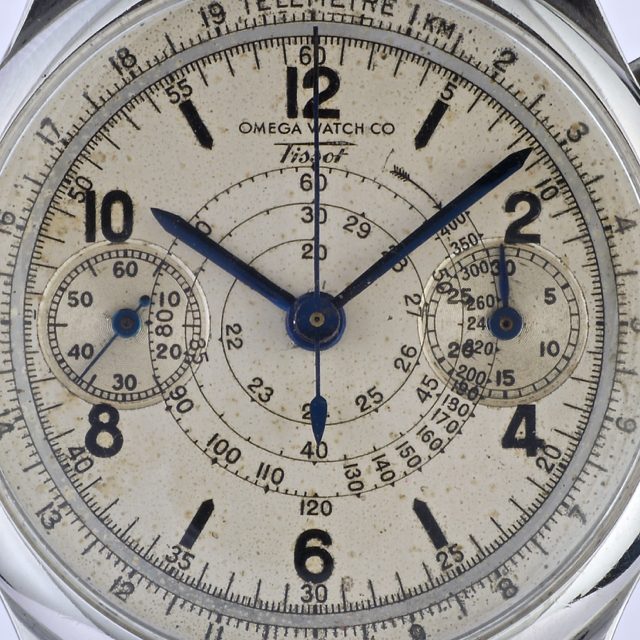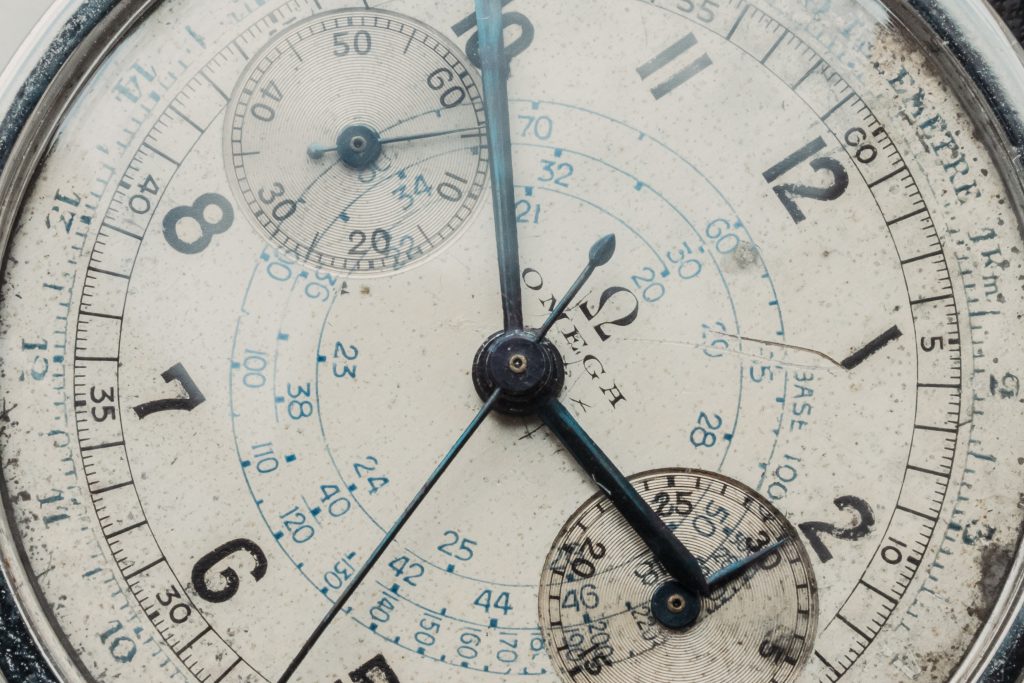Historical Background
The Omega 33.3 Chronograph CK987 is a distinguished model introduced by Omega in the late 1930s, with production continuing through the mid-1940s. This chronograph is a significant part of Omega’s history, representing the brand’s technical prowess and design excellence during a period of innovation in watchmaking. The 33.3 caliber, developed by Lemania (a sister company to Omega), was one of the first chronograph movements to feature a column-wheel mechanism, enhancing its precision and reliability.
Design and Features
– Case: The CK987 features a robust stainless steel case, measuring 37.5mm to 38mm in diameter. This size was considered large for the era, making the watch particularly notable and appealing to collectors today. The case design includes snap backs and oval pushers in early models.
– Dial: The CK987 is known for its variety of dial configurations. The most common are black or silver dials with telemetric and tachymetric scales. These features were designed for precision timing and scientific use. Many dials have aged gracefully, developing a patina that adds to their vintage charm.
– Crystal: The watch uses a Plexiglas crystal, which was standard for the time and provides durability and clarity.
– Movement: The Omega caliber 33.3 CHRO is a manual-wind movement, operating at 18,000 vibrations per hour with 17 jewels. It includes a column-wheel chronograph mechanism, which was a hallmark of high-quality chronographs of that period.
Collectibility and Market Value
The Omega 33.3 Chronograph CK987 is highly collectible due to its historical significance and limited production numbers. Estimates suggest that around 14,000 units of the caliber 33.3 were produced over approximately 20 years. Prices for well-preserved examples can range from €10,000 to €20,000, with particularly rare or well-documented pieces commanding higher prices.

Sold for €40.5k at Phillips.com
Comparison with Lemania and Tissot
Lemania, known for its robust and reliable movements, produced the 33.3 caliber used in the Omega CK987. Tissot, another brand under the same corporate umbrella as Omega and Lemania, also used Lemania movements in some of their chronographs during this period. However, Omega models typically fetch higher prices due to Omega’s stronger brand recognition and historical significance. While Tissot watches from the same era with similar movements are valued, they generally do not reach the same market levels as Omega counterparts.

Image courtesy of timeline.watch
Production and Distribution
Production of the Omega 33.3 chronographs spanned from the late 1930s to the early 1950s, with the CK987 being one of the notable references. These watches were distributed worldwide, including special orders for various markets. For example, some models were specifically delivered to regions like Guatemala, as noted by the Omega Museum records.
Dial Variations
The Omega 33.3 Chronograph CK987 is celebrated for its wide range of dial variations, each contributing to the model’s unique appeal and collectibility:
1. Black Dials: Many CK987 models feature black dials, often with gilt or white printed scales. These dials typically include telemetric and tachymetric scales, providing both functional and aesthetic value. The black dials can age to a deep brown, a characteristic highly valued by collectors.

Image courtesy of phillips.com
2. Silver Dials: Another common variation includes silver or white dials, which were often paired with blued steel hands. These dials also frequently incorporate telemetric and tachymetric scales, maintaining the model’s focus on precision and functionality.

3. Patina Development: Over time, many dials develop a patina, adding to the vintage charm of the watch. This patina can vary significantly, even among watches from the same production batch, making each piece unique.
4. Two-Register Layout: The majority of CK987 dials feature a two-register layout, with subdials for running seconds and a 30-minute counter. This configuration is preferred for its balanced aesthetic and clear readability.
5. Logo and Markings: The placement and style of the Omega logo and other dial markings can vary, with some dials featuring more prominent branding while others have a more subtle approach. These differences often help in dating and authenticating specific models.

Image courtesy of curious-curio.jp
Conclusion
The Omega 33.3 Chronograph CK987 remains a highly respected and coveted model among vintage watch enthusiasts. Its combination of technical innovation, robust design, and historical significance ensures its place as a centerpiece in any serious collection. Whether you are a seasoned collector or a new enthusiast, understanding the nuances of the CK987 and its place in horological history can enhance your appreciation for this timeless chronograph.
Interested in the CK987? Check out our example here.







